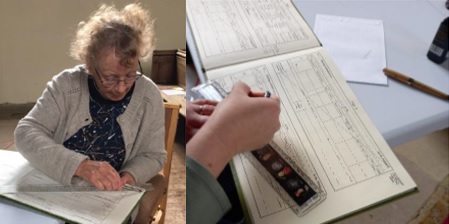End of an era
The way marriages are registered in England and Wales has just changed on 4th May 2021, when The Civil Partnerships, Marriages and Deaths (Registration Etc) Act came into force. A single electronic marriage register has been created, replacing handwritten registers. So what does this mean for our parishes?
Wiltshire's Revd Catherine Blundell writes with her view:
As if a pandemic isn’t difficult enough, the government has chosen this year to change the way marriages are registered in England. This is of insignificance for most people however, for those of us who have spent hours nervously writing the names, addresses, occupations, and other information about a couple to be married into the registers, it will be a poignant moment. From the 4th of May our marriage registers have to close.
In England, registering what are now called ‘Life Events’ was done only by the church until 1837. However, in the early 1800s, Parliament realised that if they wanted to accurately tax or count the population, or pressgang men to fight, they ought to know a bit more about what was going on. Thus, was born a hybrid of both church registration for baptisms, confirmation, marriages, and deaths alongside a civil registration process of births, marriages, and deaths.
Ever since then clergy have had to master the art of recording marriages in registrar’s ink and trying not to blot, smudge or misspell entries into what was now a legal document.
It was also supposed to be done in a very formal way. For example, the registers were supposed to be written up after the couple had married. This would have meant the ‘Signing of the Registers’ part of the marriage service would take most of the afternoon unless we sneakily filled them in ahead of time.
Then there is the fearsome registrar’s ink. A blue black substance that stains fingers, clothes and desk tops. Permanently.
As well as the language you don’t see or hear much anymore. A marriage is ‘solemnized’, according to ‘rites and ceremonies’ of the Church of England and the registers ask we record the ‘condition’ of the couple, meaning were they single, widowed, or divorced.
Yes, our marriage registers are old, large, fusty smelling and rather archaic, but they are also rather lovely, and it is with a touch of sadness that they are to be replaced with an electronic system which we are assured is easier and more secure.
Thankfully, the marriage service remains unchanged. The bride can still walk down the aisle, the best man can fumble with the rings and there is even a moment to sign the new ‘Marriage Document’. This is a boring A4 sized printed piece of paper, but the couples can still pose with pen in hand while the photographer rounds up their nearest and dearest for a formal photo.
We thought we’d make a bit of a fuss of formally closing the marriage registers which belong to your parish church. Here is a photo of the clergy, registrar’s ink in (an on) hand, scoring out the unfilled entries before they are shipped to Trowbridge.
The Revd Jenny Taylor finalises the outgoing marriage registers
We have about 17 weddings this year across the Benefice. All in the latter half of the year and hopefully free from restrictions. So, spare a moment for us as we grapple with the new system and, for the couples to be married.
God of order and peace, we thank you for the means by which the turnings of our lives are faithfully recorded, and for those who keep the records with diligence. For the means they offer for truth-telling and justice, and the record of memory of generations past. As we prepare to commit these records to the archives, help us to leave the past in your care, and renew our trust in your changeless mercy, that brings us life and wholeness in Jesus Christ our Lord. Amen.
This piece originally appeared in the Chalke Valley Benefice Weekly Bulletin.
Document Actions



